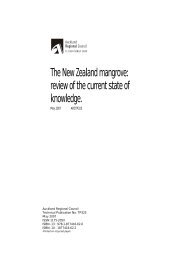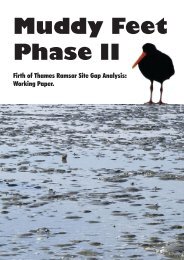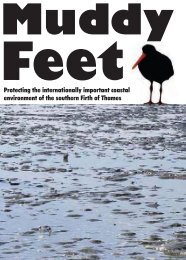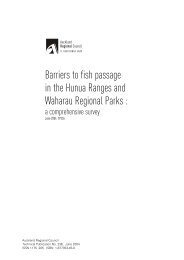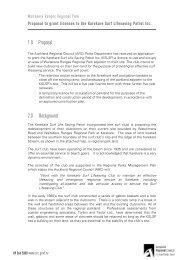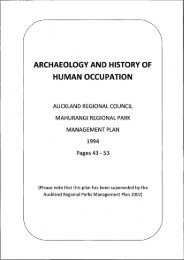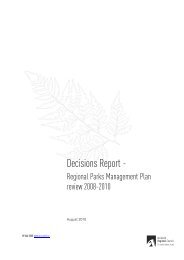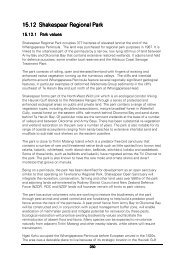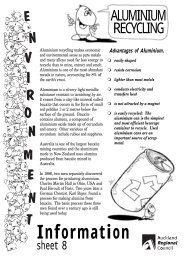MUDDY FEET - Auckland Regional Council
MUDDY FEET - Auckland Regional Council
MUDDY FEET - Auckland Regional Council
Create successful ePaper yourself
Turn your PDF publications into a flip-book with our unique Google optimized e-Paper software.
22<br />
Continuing west toward the Piako River, the vegetation between the mangal and the stopbank<br />
changes little, but Glasswort Salt Marsh becomes increasingly dominant. About five<br />
kilometres east of the Piako River, the salt marsh is about 500 metres wide. Closer to the<br />
Piako River, Sarcocornia is patchy, and kukuraho is present. Within one kilometre of the<br />
Piako River, Coprosma propinqua and C.x cunninghamii, salt marsh ribbonwood and<br />
kukuraho are common. At the mouth of the Piako, the mangal is narrow, but the mangroves<br />
are tall (up to 4 m).<br />
Dense and even aged stands of mangroves line the mouth of the Piako River. Beginning<br />
approximately four kilometres west of the Piako River on the fringes of the stopbank canal<br />
there is extensive mangrove recruitment. There are large areas of Sarcocornia salt marsh.<br />
Approximately five kilometres east of Waitakaruru there is considerable new growth of<br />
mangroves, an area browsed by stock in the mid-1990s). Kukuraho is established throughout<br />
the salt marsh close to the Waitakaruru River. Mud crabs (Helice crassa) and mud whelks<br />
were abundant.<br />
Major vegetation types<br />
Extensive and near continuous mangals occur, up to 500 metres wide, at the mouth of the<br />
Waihou River. Mangroves near the Piako River are tall and occur in dense stands.<br />
The Glasswort Salt Marsh is dominated by Sarcocornia and interspersed with batchelor’s<br />
button and occasional salt marsh ribbonwood, Coprosma and pohuehue. Adventive species in<br />
this area include Cortaderia selloana and Scotch thistle (Cirsium vulgare). Although we did<br />
not see any Spartina, a subsequent aerial survey (Thomson, 2000) established that Spartina is<br />
present in the salt marsh. Phragmites australis and Paspalum distichum were also noted.<br />
3.2.3 Hot Springs Drain to Waitakaruru (November 1998)<br />
At the mouth of the Hot Springs Drain (on the western shore of the Firth, south of Miranda)<br />
considerable build up of shells was noted. The area is characterised by near-continuous<br />
mangroves, and extensive Sarcocornia salt marsh with dense swathes of bachelor's button.<br />
Kukuraho is present along with annuals and introduced grasses. Salt marsh ribbonwood is<br />
common in the vicinity of the Hot Springs Drain. Large areas of mangrove dieback were<br />
recorded adjacent to, and south of, the Karito Canal (see chapter 4).<br />
Major vegetation types<br />
There is extensive and nearly continuous cover of mangals along this coast from the Miranda<br />
Stream south to the Waitakaruru River. Glasswort-dominated salt marsh is interspersed with<br />
batchelor’s button and salt marsh ribbonwood. Coprosma propinqua, C.x cunninghamii and<br />
pohuehue were present, but occasional.<br />
During an additional survey along the southern margin of the Karito Canal (26 July 2001) the<br />
following plants were found seaward of the stopbank floodgate:<br />
Family Juncaceae<br />
Juncus maritimus Lamarck var. australiensis Buchenau (Sea Rush)<br />
Family Poaceae<br />
*Agrostis stolonifera L. (Creeping Bent)<br />
*Polypogon monspeliensis (L.) Desf. (Beard Grass)<br />
*Schedonorus phoenix (Scop.) Holub (Tall Fescue)<br />
Family Polygonaceae<br />
Muehlenbeckia complexa (Cunningham) Meissner (Pohuehue)<br />
EcoQuest Education Foundation EQRS/1 12/04



